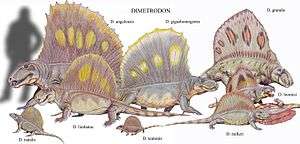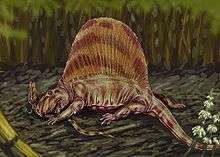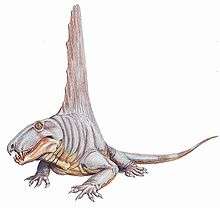List of Dimetrodon species

Twenty species of Dimetrodon have been named since the genus was first described in 1878. Many have been synonymized with older named species, and some now belong to different genera.
Dimetrodon limbatus

Dimetrodon limbatus was first described by Edward Drinker Cope in 1877 as Clepsydrops limbatus.[1] (The name Clepsydrops was first coined by Cope in 1875 for sphenacodontid remains from Vermilion County, Illinois, and was later employed for many sphenacontid specimens from Texas; many new species of sphenacodontids from Texas were assigned to either Clepsydrops or Dimetrodon in the late nineteenth and early twentieth centuries.) Based on a specimen from the Red Beds of Texas, it was the first known sail-backed synapsid. In 1940, paleontologists Alfred Romer and Llewellyn Ivor Price reassigned C. limbatus to the genus Dimetrodon, making D. limbatus the type species of Dimetrodon.[2]
Dimetrodon incisivus
The first use of the name Dimetrodon came in 1878 when Cope named the species Dimetrodon incisivus along with Dimetrodon rectiformis and Dimetrodon gigas.[3]
Dimetrodon rectiformis
Dimetrodon rectiformis was named alongside Dimetrodon incisivus in Cope's 1878 paper, and was the only one of the three named species to preserve elongated neural spines.[3] In 1907, paleontologist E. C. Case moved D. rectiformis into the species D. incisivus.[4] D. incisivus was later synonymous with the type species Dimetrodon limbatus, making D. rectiformis a synonym of D. limbatus.[5]
Dimetrodon semiradicatus
Described in 1881 on the basis of upper jaw bones, Dimetrodon semiradicatus was the last species named by Cope.[6] In 1907, E. C. Case synonymized D. semiradicatus with D. incisivus based on similarities in the shape of the teeth and skull bones.[4] D. incisivus' and D. semiradicatus are now considered synonyms of D. limbatus.[5]
Dimetrodon dollovianus
Dimetrodon dollovianus was first described by Edward Drinker Cope in 1888 as Embolophorus dollovianus. In 1903, E. C. Case published a lengthy description of E. dollovianus, which he later referred to Dimetrodon.[7]
Dimetrodon grandis

Paleontologist E. C. Case named a new species of sail-backed synapsid, Theropleura grandis, in 1907.[4] In 1940, Alfred Romer and Llewellyn Ivor Price reassigned Theropleura grandis to Dimetrodon, erecting the species D. grandis.[2]
Dimetrodon gigas
In his 1878 paper on fossils from Texas, Cope named Clepsydrops gigas along with the first named species of Dimetrodon, D. limbatus, D. incisivus, and D. rectiformis.[3] Case reclassified C. gigas as a new species of Dimetrodon in 1907.[4] Case also described a very well preserved skull of Dimetrodon in 1904, attributing it to the species Dimetrodon gigas.[8] In 1919, Charles W. Gilmore attributed a nearly complete specimen of Dimetrodon to D. gigas.[9] Dimetrodon gigas is now recognized as a synonym of D. grandis.[10]
Dimetrodon giganhomogenes

Dimetrodon giganhomogenes was named by E. C. Case in 1907 and is still considered a valid species of Dimetrodon.[4][5]
Dimetrodon macrospondylus
Dimetrodon macrospondylus was first described by Cope in 1884 as Clepsydrops macrospondylus. In 1907, Case reclassified it as Dimetrodon macrospondylus.[4]
Dimetrodon platycentrus
Dimetrodon platycentrus was first described by Case in his 1907 monograph. It is now considered a synonym of Dimetrodon macrospondylus.[5]
Dimetrodon natalis

Paleontologist Alfred Romer erected the species Dimetrodon natalis in 1936, previously described as Clepsydrops natalis. D. natalis was the smallest known species of Dimetrodon at that time, and was found alongside remains of the larger-bodied D. limbatus.[11]
Dimetrodon booneorum
Dimetrodon booneorum was first described by Alfred Romer in 1937 on the basis of remains from Texas.[11]
"Dimetrodon" kempae
Dimetrodon kempae was named by Romer in 1937, in the same paper as D. booneorum, D. loomisi, and D. milleri.[11] Dimetrodon kempae was named on the basis of a single humerus and a few vertebrae, and may therefore be a nomen dubium that cannot be distinguished as a unique species of Dimetrodon.[12] In 1940, Romer and Price raised the possibility that D. kempae may not fall within the genus Dimetrodon, preferring to classify it as Sphenacodontidae incertae sedis.[2]
Dimetrodon loomisi

Dimetrodon loomisi was first described by Alfred Romer in 1937 along with D. booneorum, D. kempae, and D. milleri.[11] Remains have been found in Texas and Oklahoma.
Dimetrodon milleri

Dimetrodon milleri was described by Romer in 1937.[11] It is one of the smallest species of Dimetrodon in North America and may be closely related to D. occidentalis, another small-bodied species.[13] D. milleri is known from two skeletons, one nearly complete (MCZ 1365) and another less complete but larger (MCZ 1367). D. milleri is the oldest known species of Dimetrodon.
Besides its small size, D. milleri differs from other species of Dimetrodon in that its neural spines are circular rather than figure-eight shaped in cross-section. Its vertebrae are also shorter in height relative to the rest of the skeleton than those of other Dimetrodon species. The skull is tall and the snout is short relative to the temporal region. A short vertebrae and tall skull are also seen in the species D. booneorum, D. limbatus and D. grandis, suggesting that D. milleri may be the first of an evolutionary progression between these species.
Dimetrodon angelensis

Dimetrodon angelensis was named by paleontologist Everett C. Olson in 1962.[14] Specimens of the species were reported from the San Angelo Formation of Texas.[15] It is also the largest species of Dimetrodon.
Dimetrodon occidentalis
Dimetrodon occidentalis was named in 1977 from New Mexico.[16] Its name means "western Dimetrodon" because it is the only North American species of Dimetrodon known west of Texas and Oklahoma. It was named on the basis of a single skeleton belonging to a relatively small individual. The small size of D. occidentalis is similar to that of D. milleri, suggesting a close relationship. Dimetrodon specimens found in Utah and Arizona probably also belong to D. occidentalis.[13]
Dimetrodon teutonis
Dimetrodon teutonis was named in 2001 from the Saar Nahe Basin of Germany and was the first species of Dimetrodon to be described outside North America. It is also the smallest species of Dimetrodon.[12]
Species assigned to different genera
Dimetrodon cruciger
In 1878, Cope published a paper called "The Theromorphous Reptilia" in which he described Dimetrodon cruciger.[17] D. cruciger was distinguished by the small projections that extended from either side of each neural spine like the branches of a tree.[18] In 1886, Cope moved D. cruciger to the genus Naosaurus because he considered its spines so different from those of other Dimetrodon species that the species deserved its own genus.[19] Naosaurus would later be synonymized with Edaphosaurus, a genus which Cope named in 1882 on the basis of skulls that evidently belonged to herbivorous animals given their blunt crushing teeth.[20]
Dimetrodon longiramus
E. C. Case named the species Dimetrodon longiramus in 1907 on the basis of a scapula and elongated mandible from the Belle Plains Formation of Texas.[4] In 1940, Romer and Price recognized that the D. longiramus material belonged to the same taxon as another specimen described by paleontologist Samuel Wendell Williston in 1916, which included a similarly elongated mandible and a long maxilla.[2] Williston did not consider his specimen to belong to Dimetrodon but instead classified it as an ophiacodontid.[21] Romer and Price assigned Case and Williston's specimens to a newly erected genus and species, Secodontosaurus longiramus, that was closely related to Dimetrodon.[2][22]
References
- ↑ Cope, E.D. (1877). "Descriptions of extinct vertebrata from the Permian and Triassic Formations of the United States". Proceedings of the American Philosophical Society. 17 (100): 182–193. JSTOR 982295.
- 1 2 3 4 5 Romer, A.S.; Price, L.I. (1940). "Review of the Pelycosauria". Geological Society of America Special Paper. 28: 1–538. doi:10.1130/spe28-p1.
- 1 2 3 Cope, E.D. (1878). "Descriptions of extinct Batrachia and Reptilia from the Permian formation of Texas". Proceedings of the American Philosophical Society. 17 (101): 505–530. JSTOR 982652.
- 1 2 3 4 5 6 7 Case, E.C. (1907). Revision of the Pelycosauria of North America. Washington, D.C.: Carnegie Institution of Washington. pp. 1–176.
- 1 2 3 4 Huttenlocker, A.K.; Rega, E.; Sumida, S.S. (2010). "Comparative anatomy and osteohistology of hyperelongate neural spines in the sphenacodontids Sphenacodon and Dimetrodon (Amniota: Synapsida)". Journal of Morphology. 271 (12): 1407–1421. doi:10.1002/jmor.10876.
- ↑ Cope, E.D. (1881). "On some new Batrachia and Reptilia from the Permian Red Beds of Texas". Bulletin of the United States Geological Survey. 6: 79–82.
- ↑ Case, E.C. (1903). "The osteology of Embolophorus dollovianus, Cope, with an attempted restoration". The Journal of Geology. 11 (1): 1–28. Bibcode:1903JG.....11....1C. doi:10.1086/621055. JSTOR 10.2307/30056735.
- ↑ Case, E.C. (1904). "The osteology of the skull of the pelycosaurian genus, Dimetrodon". The Journal of Geology. 12 (4): 304–311. Bibcode:1904JG.....12..304C. doi:10.1086/621157. JSTOR 10.2307/30055825.
- ↑ Gilmore, C.W. (1919). "A mounted skeleton of Dimetrodon gigas in the United States National Museum, with notes on the skeletal anatomy" (PDF). Proceedings of the U.S. National Museum. 56 (2300): 525–539. doi:10.5479/si.00963801.56-2300.525.
- ↑ Henrici, A.C.; Berman, D.S.; Lucas, S.G.; Heckert, A.B.; Rinehart, L.F.; Zeigler, K.E. (2005). "The carpus and tarsus of the Early Permian synapsid Sphenacodon ferox (Eupelycosauria: Sphenacodontidae)". In Lucas, S.G.; and Zeigler, K.E. (eds.). The Nonmarine Permian (PDF). New Mexico Museum of Natural History and Science Bulletin. 30. Albuquerque: New Mexico Museum of Natural History and Science. pp. 106–110.
- 1 2 3 4 5 Romer, A.S. (1937). "New genera and species of pelycosaurian reptiles" (PDF). Proceedings of the New England Zoological Club. 16: 89–97.
- 1 2 Berman, D.S.; Reisz, R.R.; Martens, T.; Henrici, A.C. (2001). "A new species of Dimetrodon (Synapsida: Sphenacodontidae) from the Lower Permian of Germany records first occurrence of genus outside of North America" (PDF). Canadian Journal of Earth Sciences. 38: 803–812. doi:10.1139/cjes-38-5-803.
- 1 2 Madalena, K.; Sumida, S.; Zeigler, K.; Rega, E. (2007). "A new record of the Early Permian pelycosaurian-grade synapsid Dimetrodon (Eupelycosauria: Sphenacodontidae) from the Lower Cutler Group (Early Permian) of Jemez Pueblo, north-central New Mexico". Journal of Vertebrate Paleontology. 27 (3, Suppl.): 110A. doi:10.1080/02724634.2007.10010458.
- ↑ Olson, E.C. (1962). "Late Permian terrestrial vertebrates, USA and USSR". Transactions of the American Philosophical Society. 52 (2): 1–224. doi:10.2307/1005904.
- ↑ Battail, B. (2000). "A comparison of Late Permian Gondwanan and Laurasian amniote faunas". Journal of African Earth Sciences. 31: 165–174. doi:10.1016/S0899-5362(00)00081-6.
- ↑ Berman, D.S. (1977). "A new species of Dimetrodon (Reptilia, Pelycosauria) from a non-deltaic facies in the Lower Permian of north-central New Mexico". Journal of Paleontology. 51 (1): 108–115.
- ↑ Cope, E.D. (1878). "The Theromorphous Reptilia". The American Naturalist. 12: 829–830. doi:10.1086/272251.
- ↑ Cope, E.D. (1880). "Second contribution to the history of the vertebrata of the Permian Formation of Texas". Proceedings of the American Philosophical Society. 19 (107): 38–58. JSTOR 982605.
- ↑ Cope, E.D. (1886). "The long-spined Theromorpha of the Permian Epoch". The American Naturalist. 20: 544–545. doi:10.1086/274275.
- ↑ Cope, E.D. (1882). "Third contribution to the history of the vertebrata of the Permian Formation of Texas". Proceedings of the American Philosophical Society. 20 (112): 447–461. JSTOR 10.2307/982692.
- ↑ Williston, S.W. (1916). "The osteology of some American Permian vertebrates, II". Contribution from the Walker Museum. 1: 165–192.
- ↑ Reisz, R. R.; Berman, D. S.; Scott, D. (1992). "The cranial anatomy and relationships of Secodontosaurus, an unusual mammal-like reptile (Synapsida: Sphenacodontidae) from the early Permian of Texas". Zoological Journal of the Linnean Society. 104 (2): 127. doi:10.1111/j.1096-3642.1992.tb00920.x.